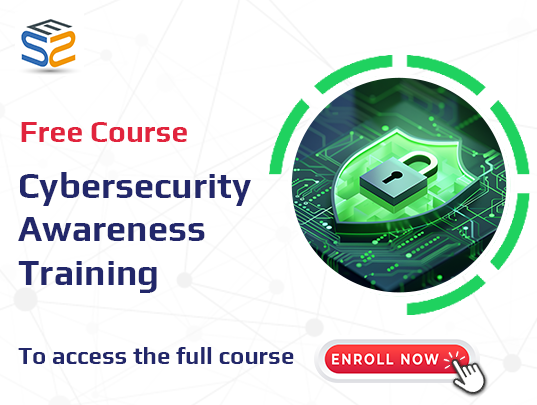
Cybersecurity Fundamentals
(SES-0001)
Learn essential skills to protect data and systems from cyber threats.
CYBERSECURITY AWARENESS – FREE ONLINE TRAINING COURSE
The Cybersecurity Online Training Course is an awareness program designed to protect individuals and organizations from cyber threats by reducing the risk of data breaches and unauthorized access by hackers and cybercriminals.
The Cybersecurity awareness training program covers the basics and important concepts on how to keep digital information safe. It is essential for everyone who uses computers or networks to be aware of the potential risks they may face online.
WHAT THIS COURSE OFFERS
M1: Introduction to Cybersecurity
M2: Social Engineering Attacks
M3: Defending Against Malware
M4: Passwords & Authentication
M5: Protecting Devices & Data
M6: Cyber-Safe Work Environment
M7: Security IPS, IDS & Firewalls
M8: Cloud Security Framework
M9: Cybersecurity Compliance
M10: Final Assessment
WHAT YOU WILL LEARN
By the end of this training program, you will be able to:
1. Learn what cybersecurity is and why it is important.
2. Identify different types of cyberattacks and understand key cybersecurity terms.
3. Learn about social engineering and phishing attacks and how to protect against them.
4. Understand different kinds of malware and how to protect against them.
5. Follow best practices for creating and managing passwords and user authentication.
6. Learn safe internet practices to protect your devices and personal information.
7. Know about a safe work environment and manage access controls effectively.
8. Learn about network security tools like Firewall, Intrusion Prevention Systems (IPS), and Intrusion Detection Systems (IDS).
9. Understand the different rules and regulations of cybersecurity for protecting various types of data.
FREQUENTLY ASKED QUESTIONS (FAQS)
1. What is Cybersecurity?
Cybersecurity refers to the practice of protecting systems, networks, and data from digital attacks, theft, or damage. It encompasses various technologies, processes, and practices designed to safeguard devices and data.
2. Who is at risk for Cyberattacks?
Individuals, small businesses, large corporations, and government agencies connected to the internet using a PC, Laptop, or any mobile device are all potential targets for cyberattacks.
3. How to protect my personal information online?
Protect your information by using strong passwords, enabling two-factor authentication, avoiding public Wi-Fi for sensitive transactions, and being cautious with the information you share.
4. What is the difference between a virus and malware?
Malware is a broad term that encompasses any malicious software, including viruses, worms, and Trojans, whereas a virus is a specific type of malware that replicates itself by infecting other files.
5. What are the benefits of cybersecurity training for employees?
Cybersecurity training helps employees recognize potential threats, understand best practices for data protection, and reduce the risk of human error, which is often a leading cause of security breaches.
6. Is the course accessible on mobile devices and tablets?
Our eLearning solution ensures that all customized eLearning courses are optimized for mobile devices, tablets, and desktops, making it easy for learners to access courses anytime, anywhere, and on any device.
7. Can the cybersecurity course content be adapted for my organization’s specific needs?
Yes! As a leading provider of custom eLearning solutions, we specialize in tailoring cybersecurity course content to meet the specific needs of your organization. Our team will work closely with you to ensure the training aligns with your policies, procedures, and compliance standards, creating a relevant and impactful learning experience for your employees.
- M1: Introduction to Cybersecurity
- M2: Social Engineering Attacks
- M3: Defending Against Malware
- M4: Passwords & Authentication
- M5: Protecting Devices & Data
- M6: Cyber-Safe Work Environment
- M7: Security IPS, IDS & Firewalls
- M8: Cloud Security Framework
- M9: Cybersecurity Compliance
- M10: Final Assessment
Student Reviews
Feedback from students who have taken this course.

